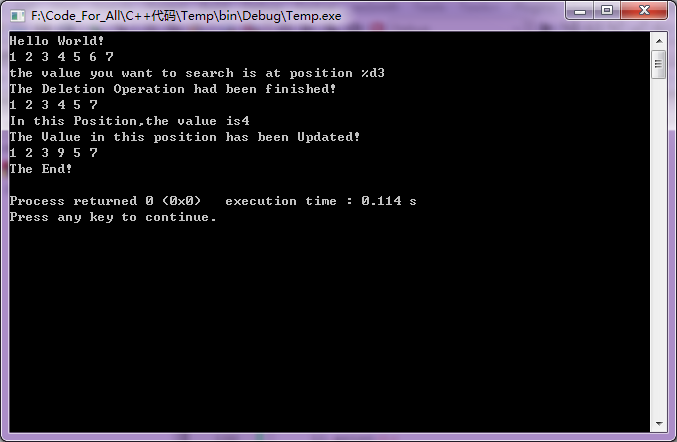- ubuntu12.04环境下使用kvm ioctl接口实现最简单的虚拟机
- Ubuntu 通过无线网络安装Ubuntu Server启动系统后连接无线网络的方法
- 在Ubuntu上搭建网桥的方法
- ubuntu 虚拟机上网方式及相关配置详解
CFSDN坚持开源创造价值,我们致力于搭建一个资源共享平台,让每一个IT人在这里找到属于你的精彩世界.
这篇CFSDN的博客文章C++ 数据结构链表的实现代码由作者收集整理,如果你对这篇文章有兴趣,记得点赞哟.
C++ 链表 。
之前一直没怎么在意C++中的链表,但是突然一下子让自己写,就老是出错。没办法,决定好好恶补一下该方面的知识,也为今后的数据结构大下个良好的基础,于是我总结出以下几点,有些地方可能不正确,还望大家不吝赐教,旨在共同进步.
总结:
1、链表List的基本单元是节点Node,因此想要操作方便,就必须为每一步打好基础,Node的基本结构如下:
|
1
2
3
4
5
6
7
8
9
|
class
Node{
public
:
int
data;
Node *next;
Node(
int
da=0,Node *p=NULL){
this
->data=da;
this
->next=p;
}
};
|
我们可以看出,Node的成员变量一共有两个,都是public,因为我们要对这两个变量进行操作,所以不能是private类型的。然后是一个构造函数,第二个参数默认值为NULL,也就是说如果我们创建新节点时只指定第一个参数,而不写第二个参数,那么它默认的就是NULL,以这种方式可以更灵活的使用Node,个人建议这么使用哦.
2、第二步就是创建我们的链表了,同样我们这里先给出链表的代码,在进行一一的解释.
|
1
2
3
4
5
6
7
8
9
10
11
12
|
class
List{
private
:
Node *head,*tail;
int
position;
public
:
List(){head=tail=NULL;};
~List(){
delete
head;
delete
tail;};
void
print();
void
Insert(
int
da=0);
void
Delete(
int
da=0);
void
Search(
int
da=0);
};
|
我们这里面有两个数据类型,一个是Node。另一个是指代节点位置的成员变量(起不到什么作用,且不去管它吧)。使用head和tail来命名便是为了见名知意,使操作更加准确。然后是重要的六个函数,各自的功能不言而喻咯,其实最重要的是在每一个函数中我们都默认能操作head和tail两个成员变量,这样能简化我们的参数列表,使得函数更加优雅.
下面是我的一个单链表的实现,包含创建链表,插入值,删除特定的值,查找特定值得在链表中的位置.
|
1
2
3
4
5
6
7
8
9
10
11
12
13
14
15
16
17
18
19
20
21
22
23
24
25
26
27
28
29
30
31
32
33
34
35
36
37
38
39
40
41
42
43
44
45
46
47
48
49
50
51
52
53
54
55
56
57
58
59
60
61
62
63
64
65
66
67
68
69
70
71
72
73
74
75
76
77
78
79
80
81
82
83
84
85
86
87
88
89
90
91
92
93
94
95
96
97
98
99
100
101
102
103
104
105
106
107
108
109
110
111
112
113
114
115
116
117
118
119
120
121
122
123
124
125
126
127
128
129
130
131
132
133
134
135
136
137
138
139
140
|
#include<iostream>
using
namespace
std;
class
Node{
public
:
int
data;
Node *next;
Node(
int
da=0,Node *p=NULL){
this
->data=da;
this
->next=p;
}
};
class
List{
private
:
Node *head,*tail;
int
position;
public
:
List(){head=tail=NULL;};
~List(){
delete
head;
delete
tail;};
void
print();
void
Insert(
int
da=0);
void
Delete(
int
da=0);
void
Search(
int
da=0);
int
getValueAt(
int
position);
void
setValueAt(
int
position,
int
da);
};
int
List::getValueAt(
int
position){
Node *p=head;
if
(p==NULL){
cout<<
"The List is Empty!"
<<endl;
}
else
{
int
posi=0;
while
(p!=NULL&&posi!=position){
posi++;
p=p->next;
}
if
(p==NULL){
cout<<
"There is no value of this position in this List!"
<<endl;
}
else
{
cout<<
"In this Position,the value is"
<<p->data<<endl;
}
}
return
p->data;
}
void
List::setValueAt(
int
position,
int
da){
Node *p=head;
if
(p==NULL){
cout<<
"The List is Empty!"
<<endl;
}
else
{
int
posi=0;
while
(p!=NULL&&posi!=position){
posi++;
p=p->next;
}
if
(p==NULL){
cout<<
"There is No Position in this List!"
<<endl;
}
else
{
p->data=da;
cout<<
"The Value in this position has been Updated!"
<<endl;
}
}
}
void
List::Search(
int
da){
Node *p=head;
if
(p==NULL){
cout<<
"Sorry, The List is Empty!"
<<endl;
return
;
}
int
count=0;
while
(p!=NULL&&p->data!=da){
p=p->next;
count++;
}
cout<<
"the value you want to search is at position %d"
<<count<<endl;
}
void
List::Delete(
int
da){
Node *p=head,*q=head;
if
(p==NULL){
cout<<
"Sorry, The List is Empty!"
<<endl;
return
;
}
while
(p!=NULL&&p->data!=da){
q=p;
p=p->next;
}
q->next=p->next;
cout<<
"The Deletion Operation had been finished!"
<<endl;
}
void
List::Insert(
int
da){
if
(head==NULL){
head=tail=
new
Node(da);
head->next=NULL;
tail->next=NULL;
}
else
{
Node *p=
new
Node(da);
tail->next=p;
tail=p;
tail->next=NULL;
}
}
void
List::print(){
Node *p=head;
while
(p!=NULL){
cout<<p->data<<
" \a"
;
p=p->next;
}
cout<<endl;
}
int
main(){
cout<<
"Hello World!"
<<endl;
List l1;
l1.Insert(1);
l1.Insert(2);
l1.Insert(3);
l1.Insert(4);
l1.Insert(5);
l1.Insert(6);
l1.Insert(7);
l1.print();
l1.Search(4);
l1.Delete(6);
l1.print();
l1.getValueAt(3);
l1.setValueAt(3,9);
l1.print();
cout<<
"The End!"
<<endl;
return
0;
}
//在此我想解释的是,之所以数字4在链表中的位置为3,是因为其是从零开始计数的
|
下面是代码运行后的结果:

好了,单链表的基本操作大致就是这样了,希望我们都能从中有所收获。如果您发现代码中有什么错误,还望不吝赐教,让我们共同进步吧.
感谢阅读,希望能帮助到大家,谢谢大家对本站的支持! 。
最后此篇关于C++ 数据结构链表的实现代码的文章就讲到这里了,如果你想了解更多关于C++ 数据结构链表的实现代码的内容请搜索CFSDN的文章或继续浏览相关文章,希望大家以后支持我的博客! 。
背景: 我最近一直在使用 JPA,我为相当大的关系数据库项目生成持久层的轻松程度给我留下了深刻的印象。 我们公司使用大量非 SQL 数据库,特别是面向列的数据库。我对可能对这些数据库使用 JPA 有一
我已经在我的 maven pom 中添加了这些构建配置,因为我希望将 Apache Solr 依赖项与 Jar 捆绑在一起。否则我得到了 SolarServerException: ClassNotF
interface ITurtle { void Fight(); void EatPizza(); } interface ILeonardo : ITurtle {
我希望可用于 Java 的对象/关系映射 (ORM) 工具之一能够满足这些要求: 使用 JPA 或 native SQL 查询获取大量行并将其作为实体对象返回。 允许在行(实体)中进行迭代,并在对当前
好像没有,因为我有实现From for 的代码, 我可以转换 A到 B与 .into() , 但同样的事情不适用于 Vec .into()一个Vec . 要么我搞砸了阻止实现派生的事情,要么这不应该发
在 C# 中,如果 A 实现 IX 并且 B 继承自 A ,是否必然遵循 B 实现 IX?如果是,是因为 LSP 吗?之间有什么区别吗: 1. Interface IX; Class A : IX;
就目前而言,这个问题不适合我们的问答形式。我们希望答案得到事实、引用资料或专业知识的支持,但这个问题可能会引发辩论、争论、投票或扩展讨论。如果您觉得这个问题可以改进并可能重新打开,visit the
我正在阅读标准haskell库的(^)的实现代码: (^) :: (Num a, Integral b) => a -> b -> a x0 ^ y0 | y0 a -> b ->a expo x0
我将把国际象棋游戏表示为 C++ 结构。我认为,最好的选择是树结构(因为在每个深度我们都有几个可能的移动)。 这是一个好的方法吗? struct TreeElement{ SomeMoveType
我正在为用户名数据库实现字符串匹配算法。我的方法采用现有的用户名数据库和用户想要的新用户名,然后检查用户名是否已被占用。如果采用该方法,则该方法应该返回带有数据库中未采用的数字的用户名。 例子: “贾
我正在尝试实现 Breadth-first search algorithm , 为了找到两个顶点之间的最短距离。我开发了一个 Queue 对象来保存和检索对象,并且我有一个二维数组来保存两个给定顶点
我目前正在 ika 中开发我的 Python 游戏,它使用 python 2.5 我决定为 AI 使用 A* 寻路。然而,我发现它对我的需要来说太慢了(3-4 个敌人可能会落后于游戏,但我想供应 4-
我正在寻找 Kademlia 的开源实现C/C++ 中的分布式哈希表。它必须是轻量级和跨平台的(win/linux/mac)。 它必须能够将信息发布到 DHT 并检索它。 最佳答案 OpenDHT是
我在一本书中读到这一行:-“当我们要求 C++ 实现运行程序时,它会通过调用此函数来实现。” 而且我想知道“C++ 实现”是什么意思或具体是什么。帮忙!? 最佳答案 “C++ 实现”是指编译器加上链接
我正在尝试使用分支定界的 C++ 实现这个背包问题。此网站上有一个 Java 版本:Implementing branch and bound for knapsack 我试图让我的 C++ 版本打印
在很多情况下,我需要在 C# 中访问合适的哈希算法,从重写 GetHashCode 到对数据执行快速比较/查找。 我发现 FNV 哈希是一种非常简单/好/快速的哈希算法。但是,我从未见过 C# 实现的
目录 LRU缓存替换策略 核心思想 不适用场景 算法基本实现 算法优化
1. 绪论 在前面文章中提到 空间直角坐标系相互转换 ,测绘坐标转换时,一般涉及到的情况是:两个直角坐标系的小角度转换。这个就是我们经常在测绘数据处理中,WGS-84坐标系、54北京坐标系
在软件开发过程中,有时候我们需要定时地检查数据库中的数据,并在发现新增数据时触发一个动作。为了实现这个需求,我们在 .Net 7 下进行一次简单的演示. PeriodicTimer .
二分查找 二分查找算法,说白了就是在有序的数组里面给予一个存在数组里面的值key,然后将其先和数组中间的比较,如果key大于中间值,进行下一次mid后面的比较,直到找到相等的,就可以得到它的位置。

我是一名优秀的程序员,十分优秀!